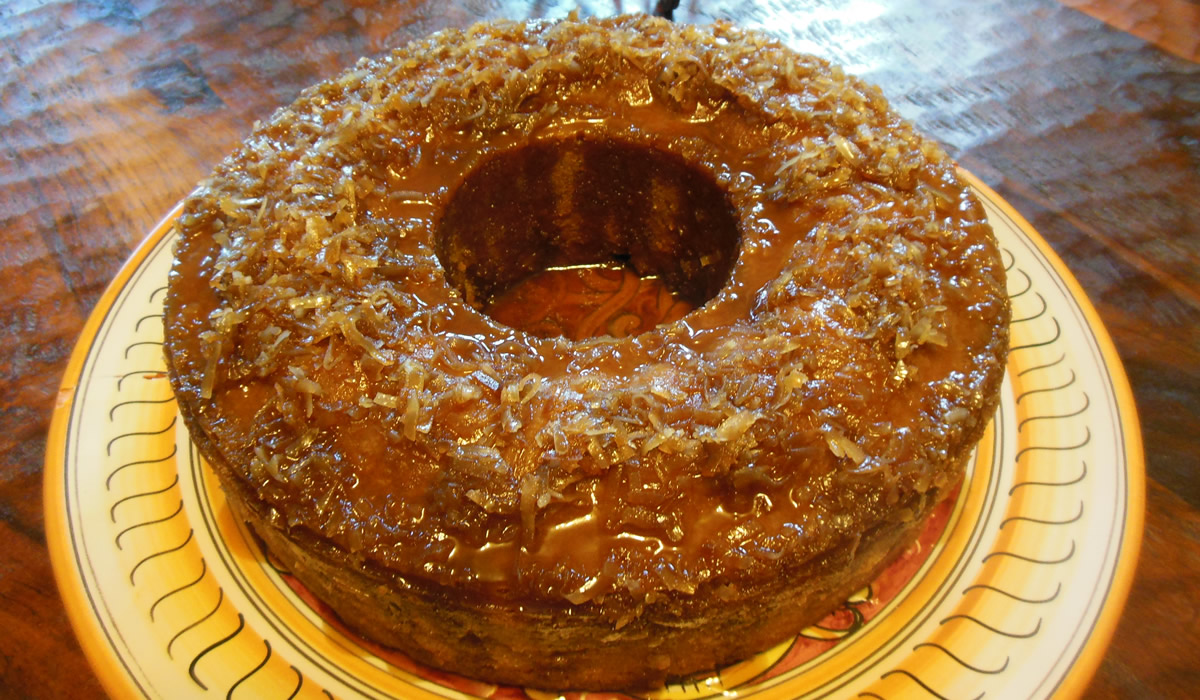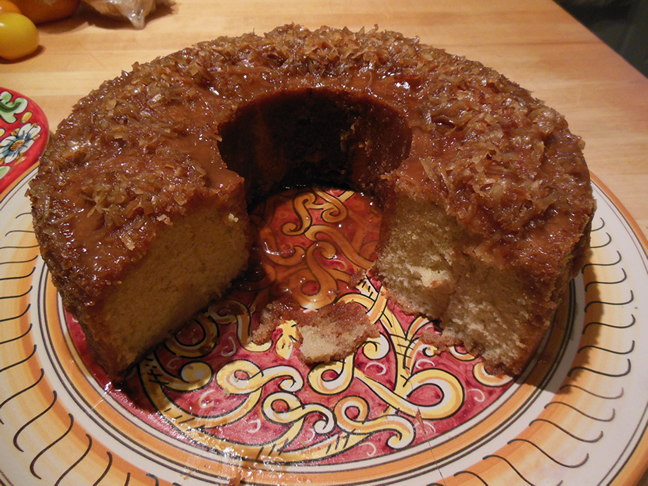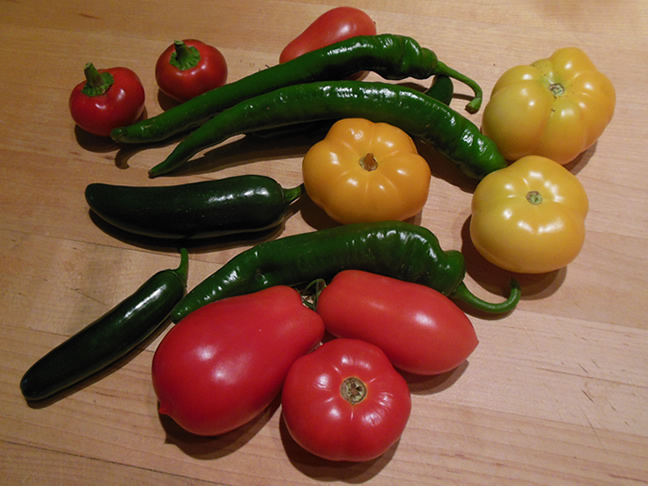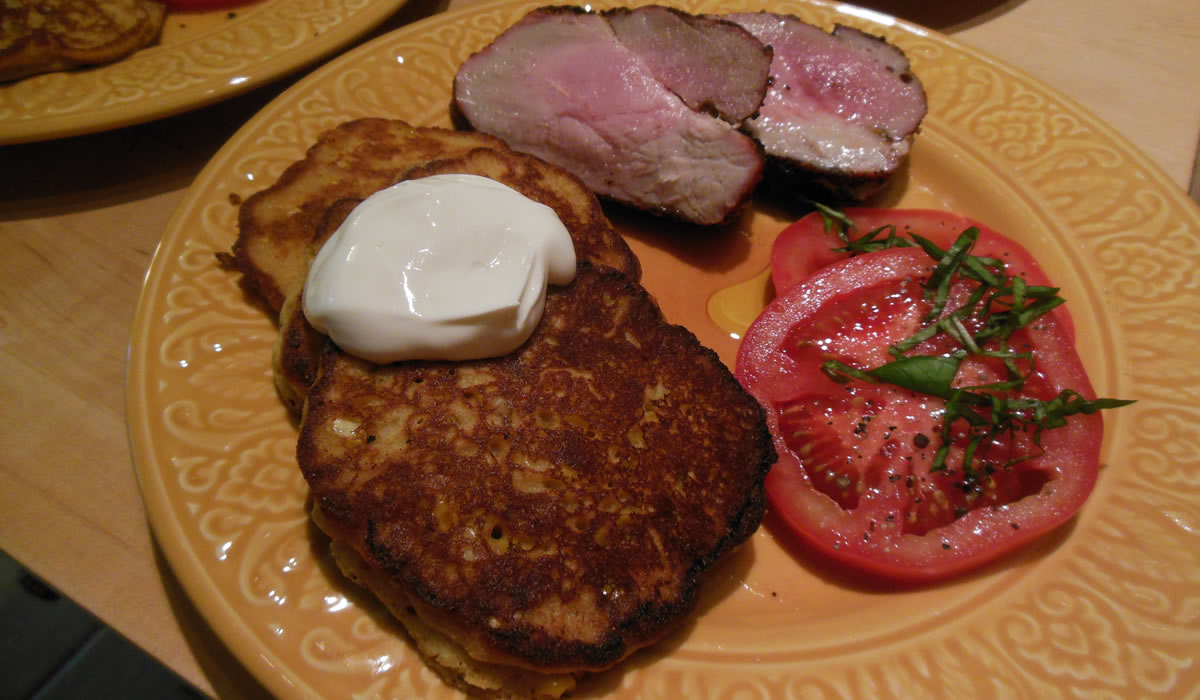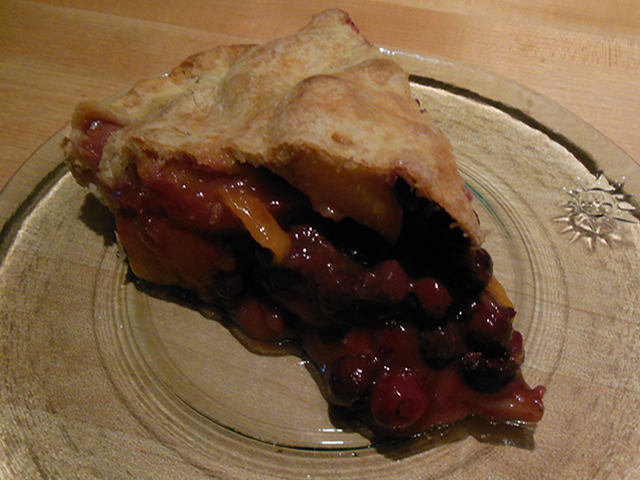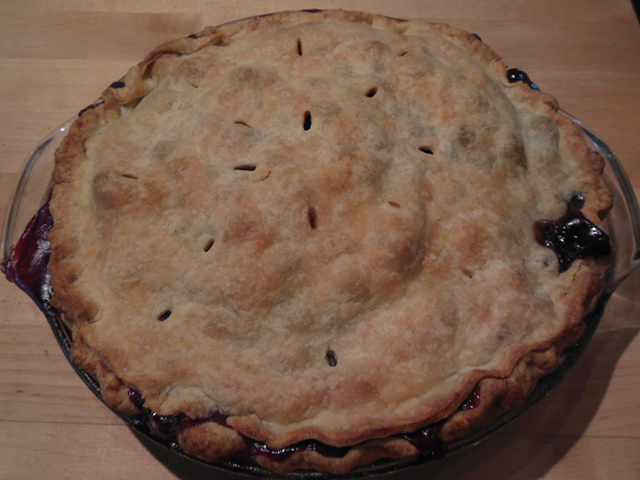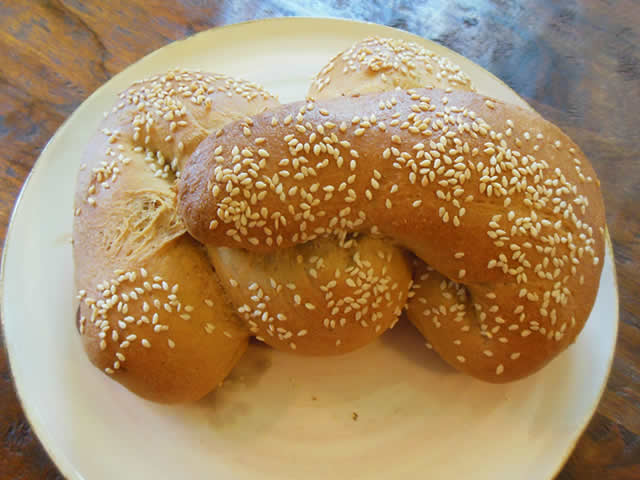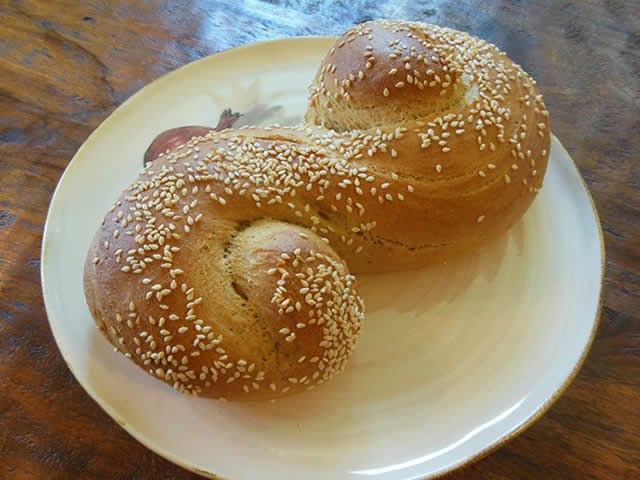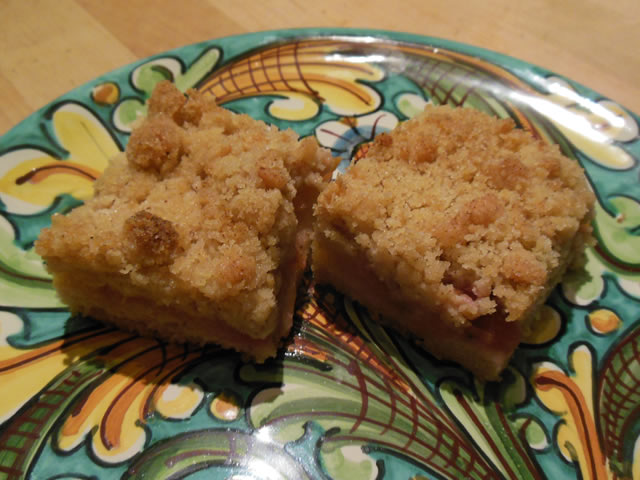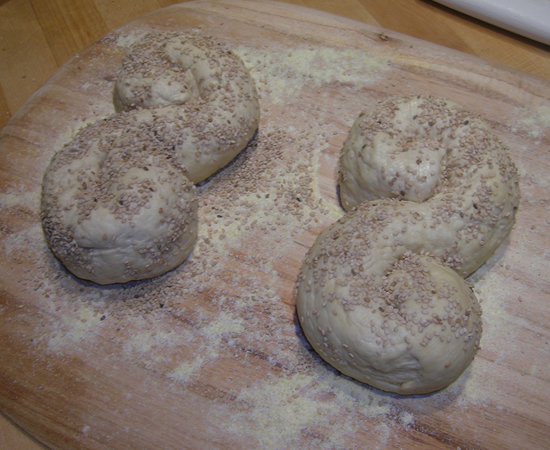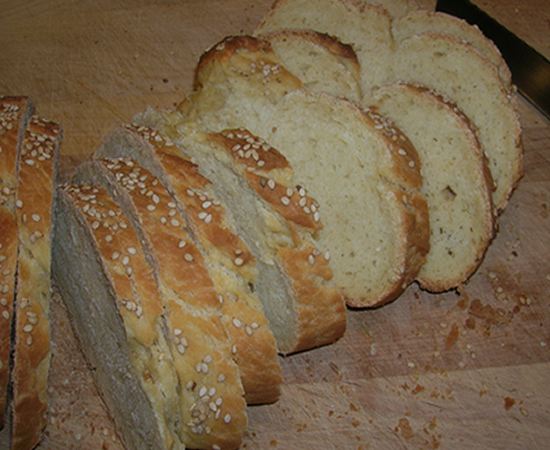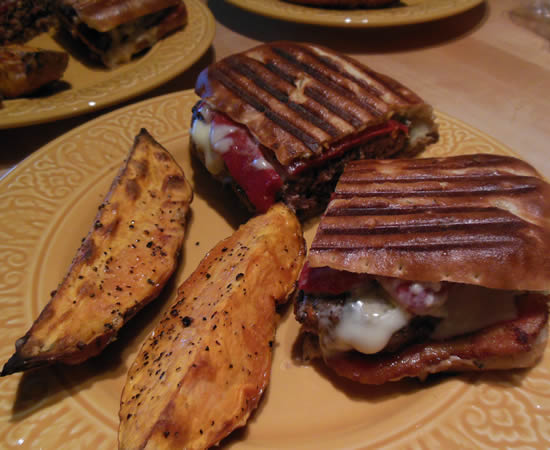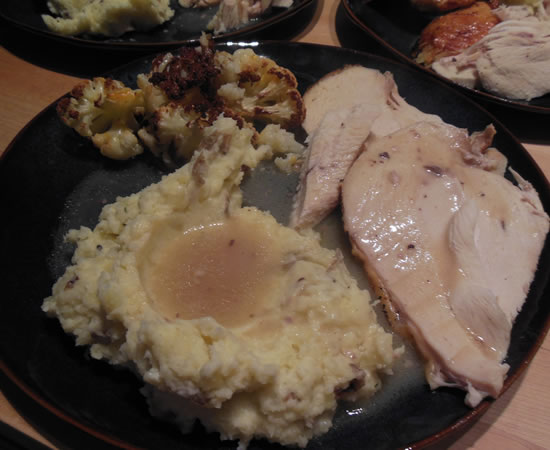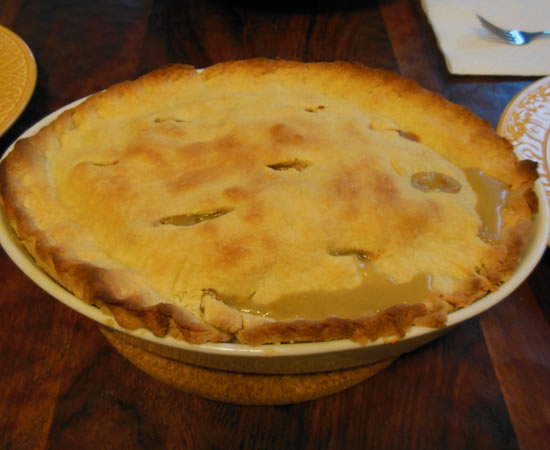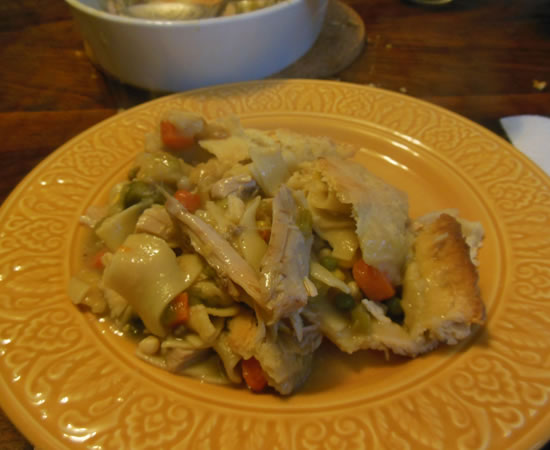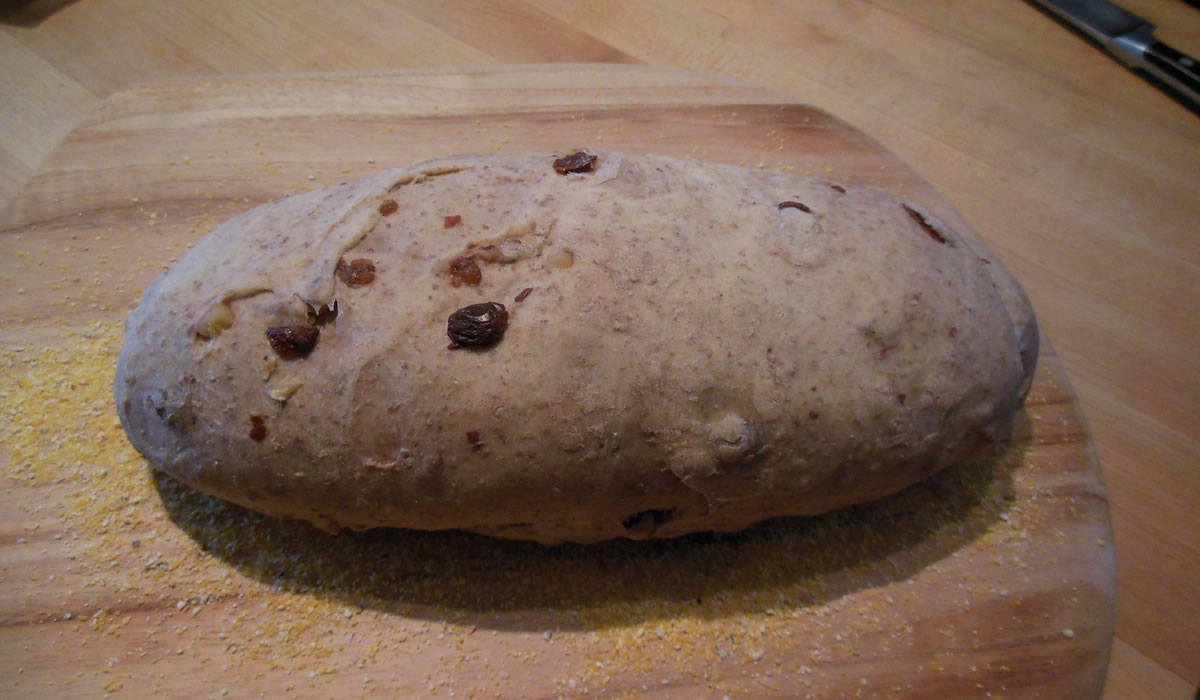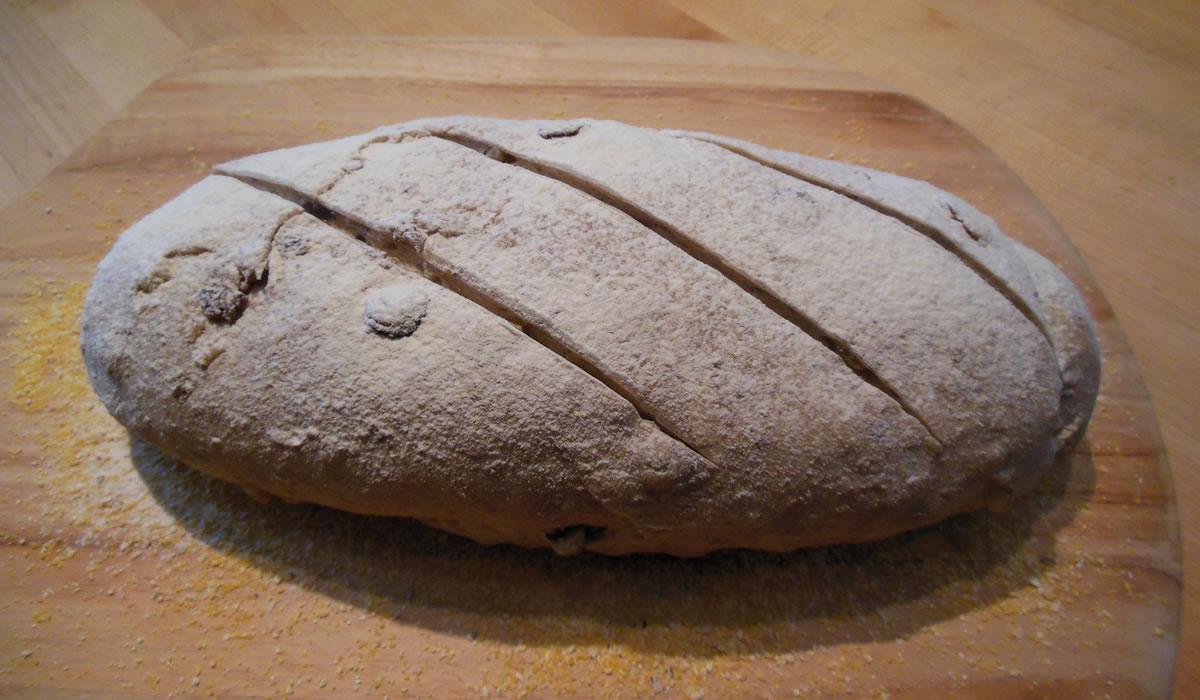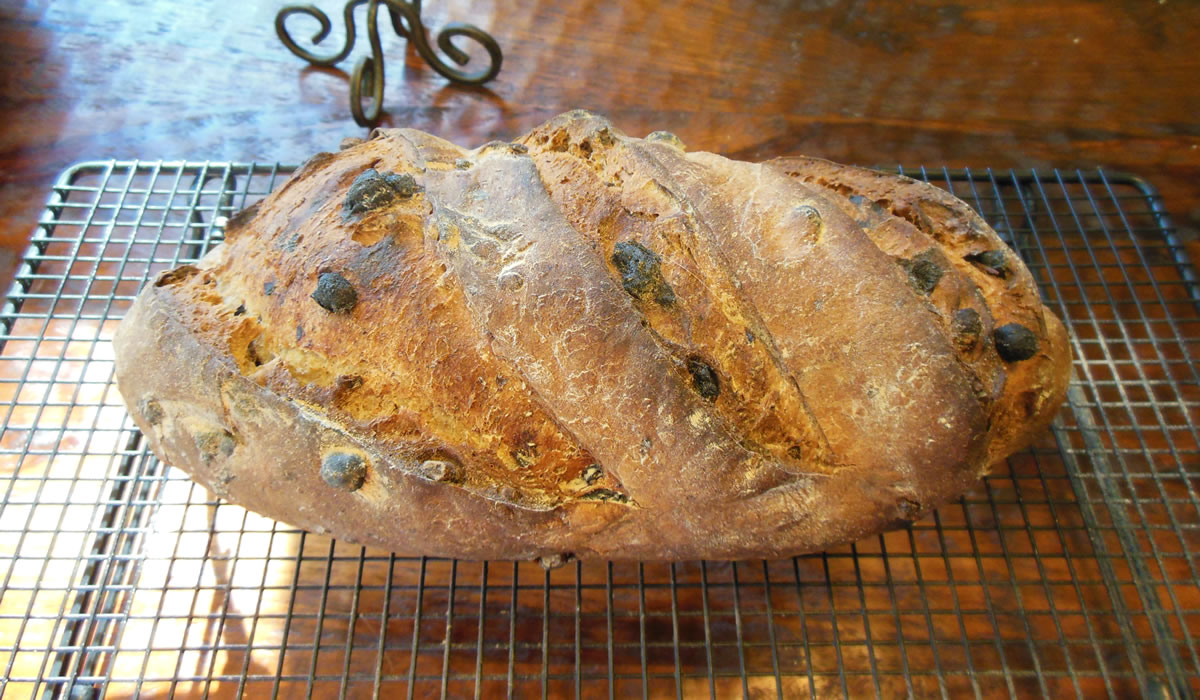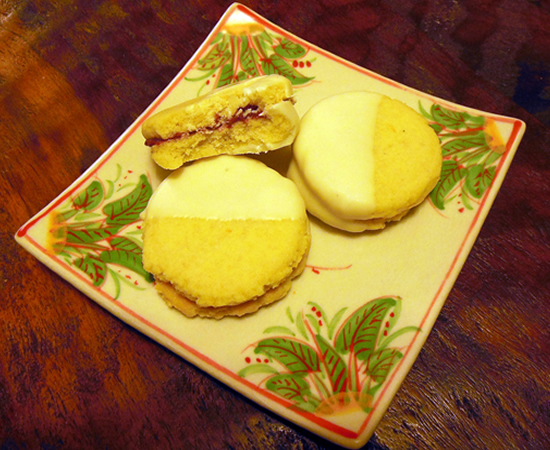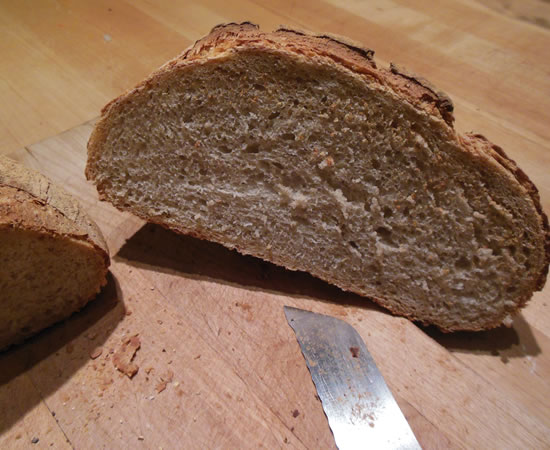Bahamian Rum Cake
Mom would have loved this cake!
While I was putting it together, I kept thinking of her making cakes, poking holes in them, pouring syrupy goodness over them... she had a lot of fun in the kitchen baking cakes and making desserts. It's obvious, considering her "Dessert" cook book is twice as thick as her cook book for everything else!
She baked a lot of cakes in her time and one memory will always be the missing little tiny corner of the 9x13 cakes. She had a habit if nicking a teensy corner - about a half-inch square - of the cake for herself. She would have killed one of us for doing it - but... she baked it!
I'm more of a batter-eater/beater-licker, m'self. And I don't usually go for teeny corners. I go large.
And large I went, today!
I just got a copy of David Lebovitz' book "Ready for Dessert." I am always ready for dessert, so I had to get it. David worked at Chez Panisse in Berkeley and has become my go-to for great baking ideas. I love that his recipes are good - not fussy. He uses real ingredients that most people have access to and explains what he does while also explaining that it's what he did - you can actually change things and it's okay.
I saw this particular cake and immediately thought of a Tortuga Rum Cake I made right after we got back from the Cayman Islands. That was one sad cake compared to this one. But then, that's why he baked at Chez Panisse and I baked on an aircraft carrier.
But even an old salt like myself couldn't screw up this perfect recipe.
There's a goodly amount of sugar in this but it never comes off as cloyingly sweet. Perfect crumb and a perfect sweet balance.
This is a three-part recipe. The 2nd and 3rd parts - both syrups - can be accomplished while the cake is baking
Bahamian Rum Cake
adapted from Ready for Dessert by David Lebovitz
The Cake:
- 3 cups flour, sifted
- 1/2 tsp baking powder
- 1/2 tsp baking soda
- 3/4 tsp salt
- 1/4 tsp freshly ground nutmeg
- 1 cup butter, room temperature
- 2 cups sugar
- 3 eggs, room temperature
- 2 egg yolks, room temperature
- 1 tbsp vanilla
- 3/4 cup good-quality canned coconut milk
Preheat your oven to 350°. Butter a 10-cup bundt pan and dust it with flour, tapping out the excess. Set aside.
n a medium bowl, sift together the flour, baking powder, baking soda, salt and nutmeg. Set aside.
In the bowl of your stand-mixer, beat together the butter and sugars, slowly increasing the speed to medium – allowing the batter to become light and fluffy (approximately 5 minutes).
In a small bowl, beat together the eggs, egg yolks and vanilla. Slowly drizzle the mixture into the creamed butter, scraping the sides as needed. Once the eggs are completely incorporated, gently stir-in one-third of the flour mixture, then about half of the coconut milk.
Mix in another third of the flour mixture, the rest of the coconut milk, and the remaining third of the flour; until just combined.
Spread the batter evenly into the prepared pan. Bake about 55 minutes or until cake is set.
While the cake is baking, make the coconut rum syrup.
Coconut Rum Syrup
- 3/4 cup coconut milk - the rest of the can you used for the cake
- 6 tbsp sugar
- 1/2 cup dark rum - like Meyers
In a medium sauce-pan , warm the remainder of the coconut milk, and the sugar , stirring until the sugar dissolves. Remove the syrup from heat and add the dark rum. Mix well and set aside until the cake comes out of the oven.
When the cake comes out of the oven - while hot - poke about 60 holes in it with a skewer. Slowly spoon about 2/3 of the syrup over the cake, letting it soak in. Cool completely in the pan.
When cool, invert onto a cake plate and brush with the remaining coconut syrup and then cover with the coconut glaze.
Coconut Glaze
- 4 tbsp butter, cut into pieces
- 6 tbsp heavy cream
- 6 tbsp brown sugar
- pinch of salt
- 1 tbsp dark rum
- 1/2 cup sweetened coconut, toasted
Toast the coconut flakes either in the oven or in a small skillet on the stove.
Combine the butter, cream, salt and sugar together in a small saucepan over high heat and bring to a boil. Stir the mixture to dissolve the sugar. Remove from the heat, whisk in the rum and toasted coconut.
Spoon the glaze over the top of the cake, letting it run down the sides.
This was one awesome cake!
I'm thinking it will make a great breakfast cake, too. I know mom would approve.
Mutiny on the Bounty
Our vision of a bountiful tomato and pepper harvest have come to naught. Timing and Mother Nature have conspired against us, this year - pitiful pickin's, indeed.
We (as in Victor) planted 7 tomato plants and 8 pepper plants the day after we returned from Sicily. The plan was to can peppers and tomato sauce to give out as Christmas gifts. We were seriously looking at the possibility of so much stuff coming ripe that along with all the jars, I bought extra lids and rings to make sure we could reuse as quickly as we emptied. Instead, we're looking to call Willie Nelson for a Farm Aid concert. There's hope that one of the plum tomato plants will still produce a bit, but if we make the sauce this year, it's going to be from canned tomatoes.
Actually, we will be making sauce at some point within the next few weeks. Whether from canned tomatoes or fresh from our yard, homemade sauce is infinitely better than the supermarket stuff, and we're going through more and more of it with Nonna's dwindling food likes. It also is easier to store. The freezer is pretty finite. We have lots of room downstairs.
Most of the folks we've spoken with are having tomato issues this year, so we're thinking it's more than just getting them into the ground 2 weeks later than usual. The weather hasn't been nearly as hot - although it hasn't been as muggy, either - which should have made them happy. It's a conundrum, indeed.
Seven tomato plants... I had hopes of making a yellow tomato sauce this year, just for something completely different. Yep. Big plans foiled by the fickle finger of fate.
Maybe another year.
Fortunately, we have some other projects going on that don't require Mother Nature's outdoor cooperation, so the Christmas stockings shan't be completely empty but I'm going to miss my hot peppers in February. And yellow tomato sauce.
Next year.
Corn Cakes
I was going through the links on the site today - seeing what was new and making sure they were all still current - when I got to David Lebovitz.
Now... I have been unashamedly in love with David since forever. He was the pastry chef at Chez Panisse for years, and his approach to desserts is everything I love - uncomplicated but intense. His Lemon Bars are the gold standard by which all others are judged.
So... while perusing his website I came across a recipe for Corn Cakes. Oh my goodness. I am a corn junkie. Fresh off the cob, ground up into corn chips or tortilla chips, corn bread, corn sticks, hushpuppies, or corn dogs, I loves me some corn.
I knew at that moment we were going to have them for dinner.
David warned that corn flour is not the same as corn meal - which I did know - but I did a bit more research since I always have masa harina on hand and learned it was not the same, either. Masa harina and corn flour look a lot alike, but they are different types of corn processed in very different ways. They are not interchangeable. Fortunately, corn flour is available right up the street from me.
So... armed with my bag of corn flour, I went to work. In absolutely no-time, I had corn cakes on the table. It's a ridiculously-easy recipe.
They were fantastic and as we were eating them we were thinking of other ways to use them - as in the base for a take on eggs benedict, for one... I would love a gooey runny yolk on one of these...
Fresh Corn Cakes
adapted from David Lebovitz who adapted it from Alice Waters
- 1 1/2 cups corn flour
- 1 1/2 tsp baking powder
- 3/4 tsp salt
- 1/2 tsp black pepper
- 4 tbsp butter
- 1 cup milk
- 1 tbsp honey
- 2 ears of fresh corn - about 2 cups
- 2 large eggs, separated
- 1 large egg white
Blend the corn flour, baking powder, salt, and pepper in a mixing bowl. Set aside.
Warm the butter with the milk and honey, until the butter is melted. Set aside until barely warm.
When cool, stir it into the dry ingredients alomng with the 2 egg yolks, and the corn.
In a separate bowl, beat the 3 egg whites until stiff and then fold them completely into the corn mixture.
Heat a pat of butter in a skillet. Using a 1/4-cup ice cream scoop, scoop batter into the pan, spacing them comfortably apart.
Cook the cakes until browned on the bottom and starting to bubble around the edges - like a pancake. Flip the corn cakes and cook on the other side until lightly browned.
Serve with sour cream, if desired.
David added cayenne and hot peppers to his. I left both out as Nonna is no longer a fan of spice, but I'll definitely add some in next time I make them. And there will be a next time!
So thank you, David and thank you Alice. It was fun...
And speaking of fun... there's a couple more of your cook books I'm going to have to get real soon...
Blueberry Peach Pie
I had planned to make a blueberry caramel the other day, based on the raspberry caramel I made last week. Notice I said planned. I didn't make it. I also had a half-dozen peaches that needed eating.
Now... I could have made a simple fruit salad and left it at that - but to paraphrase Tina Turner... we never ever do nothing nice and easy... It was time to bake a pie.
I thought of several possibilities, from crumb-top to lattice-topped to a biscuit-topped cobbler, but in the end, a traditional pie won out. A not overly-sweet traditional pie, I might add. I like my sweets, no question about it, but with fresh fruit, I want to taste the fruit. If it's good, it's sweet enough, already. And if it's not good, no amount of sugar is going to make it better.
I made my standard pie crust and while it was relaxing in the refrigerator, I went to work on the filling.
I did a quick blanch-and-peel on the peaches and cut them into fairly thick slices. Ofttimes I will leave fruit unpeeled because I actually like the taste and texture of the peel, but this time around I went for it. I used a mixture of brown and white sugar and a bit of vanilla. No other spices. Feel free to add what you like, but I thought the fruit was too good to mask.
Pie Dough
for a double crust:
- 2 cups flour
- 1/3 cup cake flour
- 1/2 lb butter, frozen
- pinch salt
- 2 tbsp sugar
- 3 tbsp ice water
- 3 tbsp chilled vodka
Using a food processor, add flour, salt, and sugar. Pulse to mix.
Chop up frozen butter and add. Pulse until butter is incorporated and mixture looks grainy.
Slowly add ice water and vodka. Pulse until mixed.
Turn out onto counter. Press and form mixture into 2 disks . Wrap in plastic and refrigerate about an hour to allow the flour to properly absorb the water and to relax the gluten.
Roll out crust and place in pie plate. Crimp edges and fill.
It really does make a difference refrigerating the pie dough. I usually end up pulling it out at 30 minutes, but an hour is best.
Today, I made a goodly amount of filling because I was using up what I had in the house and I was using a 10' deep pie plate. And I used it all. The pie bubbled over, but I had placed it on a sheet pan, so it was not a problem. You can definitely get by with less. Adjust sugars and flour, accordingly.
Blueberry Peach Pie
- 6 medium peaches
- 1 1/2 lbs blueberries
- 1/2 cup brown sugar
- 1/2 cup white sugar
- 1/4 cup flour
- 3 tbsp butter, melted
- 2 tsp vanilla
- pinch salt
Peel and thickly-slice peaches. With clean hands, gently mix in blueberries and remaining ingredients until well-blended.
Pile into prepared pie shell and cover with second crust. Crimp edges to seal and cut steam vents into top.
Place into a preheated 425° oven for 15 minutes. Reduce heat to 375° and bake an additional 50 minutes - or until crust is browned and filling is bubbling and cooked.
Cool completely before cutting.
This went over well. Really well.
When I was a little kid my grandmother would occasionally give me a piece of homemade peach pie and vanilla ice cream for breakfast. It wasn't all of the time and she rationalized that it really was no different than a peach danish and a glass of milk.
I'm thinkin' grandma would approve if I had a piece of this tomorrow morning...
Pane Siciliano Tre
I got into the kitchen early this morning. I haven't really been playing a lot, lately, and decided today was the perfect day to make up for lost calories.
First thing I did was make bread dough for Pane Siciliano. It's warm and just a tad muggy outside. Mother Nature's perfect proofing box! The recipe comes from Carol Field's The Italian Baker and is a snap to make. Oddly, the first time I made it I had some problems with the dough - it was much too dry - but I made the exact recipe again in Sicily and it came out perfect. As did the batch I made today. Methinks I screwed up the first time and just didn't realize it, because the last two batches have been excellent - using the exact same recipe.
There are three variations on shaping the dough listed in her book, so today, I decided to try one other than the 'S' I have done in the past. Both start out as a rope of dough but the one below is more like an 'M' with the end folded back over itself.
The instructions say not to tuck the final strip under the dough, but I could have made it a bit longer. It pulled back when it rose the second time.
Not that it mattered - it still tasted great!
Pane Siciliano
Makes 2 loaves
- 2 1/2 tsp active dry yeast
- 1/4 cup warm water
- 1 tbsp olive oil
- 1 tsp malt syrup
- 1 cup water, room temperature
- 2 1/2 cups durum flour or semolina for pasta
- 1 cup plus 1 tbsp unbleached all-purpose flour
- 2 to 3 tsp salt
- 1/3 cup sesame seeds
By hand:
Dissolve the yeast in the warm water in a large mixing bowl; let stand until creamy, about 10 minutes. Whisk in the oil, malt, and 1 cup of water. Mix the flours and salt and whisk in 1 cup at a time into the yeast mixture. Beat vigorously with a wooden spoon until smooth. Knead on a floured surface 8 to 10 minutes, occasionally slamming the dough down vigorously to develop the gluten.
By mixer:
Stir the yeast into the 1 1/4 cups warm water in a large mixer bowl; let stand until creamy, about 10 minutes. Stir in the oil and malt with the paddle; then add the flours and salt and mix until smooth. Change to the dough hook and knead on medium speed until; the dough is firm, compact, and elastic with lots of body, 4 to 5 minutes. Finish kneading by hand on a lightly floured surface.
First rise. Place the dough in a lightly oiled bowl, cover tightly with plastic wrap and let rise until doubled, about 1 1/2 hours. The dough should be springy and blistered, but still soft and velvety.
Shaping and second rise. Punch the dough down, knead it briefly, and let it rest for 5 minutes. Flatten it with your forearm into a square. Rollit into a long, narrow rope, about 20 to 22 inches long. The dough should be so elastic that it could almost be swung and stretched like a jump rope. Cut the dough in half and shape each into a loaf. (The book shows 3 classic shapes and illustrations; Mafalda, Occhi di Santa Lucia, and the baked Corona. I made the Santa Lucia.)
Place the loaves on floured parchment paper, peels sprinkled with corn meal, or oiled baking sheets. Brush the entire surface of each loaf with water and sprinkle with sesame seeds; pat the seeds very gently into the dough. Cover with plastic wrap, and then a kitchen towel, and let rise until doubled, 1 to 1 1/2 hours.
Baking. Thirty minutes before baking heat the oven with baking stones to 425°. Sprinkle the stones with cornmeal just before sliding the loaves onto them. Bake 10 minutes, spraying 3 times with water. Reduce the heat to 400° and bake 25 to 30 minutes longer. Cool on racks.
It really is an easy bread to make - and it really does taste great.
Give it a try.
Nectarine Squares
This is a bit of a no-brainer bar cookie that really works well with thin slices of fresh fruit. I've made it it peaches, plums, and nectarines, so far, and I imagine just about anything would work - including bananas or thin-sliced or chopped cherries. Or apricots. Or whatever looks good at the grocers or farmers market.
What's nice is there is no additional sugar in the filling - just a thin layer of fresh fruit.
Nonna loves them. She's finding lots of reasons to get up and head into the kitchen for one of those "as long as I'm here" moments!
Nectarine Squares
- 3 cups flour
- 1 cup sugar
- 1 tsp baking powder
- 1 cup butter
- 1 egg
- 1/2 tsp cinnamon
- 1/4 tsp cloves
- 1/4 tsp nutmeg
- pinch salt
- 3-4 nectarines or peaches
Preheat oven to 375°
Butter a 9×13 inch pan. Mix together sugar, baking powder, flour, salt and spices. Cut cold butter into dry ingredients. Add egg and mix well.
Press 2/3 of the crumbs into buttered pan, pressing well.
Layer nectarine slaices over packed crumbs.
Sprinkle remaining crumbs evenly over the top and bake about 30 minutes or until top is slightly brown.
Cool and then cut into squares.
Pane Siciliano
Last night I pulled out my beat-up old copy of The Italian Baker by Carol Field. I had planned on making her Pane Pugliese and it needs a biga, or starter. It's one of my most favorite breads. I was pulling the ingredients together when I turned the page and saw a recipe for Pane Siciliano. Something new. I actually had the semolina flour (shock!) and decided to give it a try.
Pane Siciliano
Makes 2 loaves
- 2 1/2 tsp active dry yeast
- 1/4 cup warm water
- 1 tbsp olive oil
- 1 tsp malt syrup
- 1 cup water, room temperature
- 2 1/2 cups durum flour or semolina for pasta
- 1 cup plus 1 tbsp unbleached all-purpose flour
- 2 to 3 tsp salt
- 1/3 cup sesame seeds
By hand:
Dissolve the yeast in the warm water in a large mixing bowl; let stand until creamy, about 10 minutes. Whisk in the oil, malt, and 1 cup of water. Mix the flours and salt and whisk in 1 cup at a time into the yeast mixture. Beat vigorously with a wooden spoon until smooth. Knead on a floured surface 8 to 10 minutes, occasionally slamming the dough down vigorously to develop the gluten.
By mixer:
Stir the yeast into the 1 1/4 cups warm water in a large mixer bowl; let stand until creamy, about 10 minutes. Stir in the oil and malt with the paddle; then add the flours and salt and mix until smooth. Change to the dough hook and knead on medium speed until; the dough is firm, compact, and elastic with lots of body, 4 to 5 minutes. Finish kneading by hand on a lightly floured surface.
First rise. Place the dough in a lightly oiled bowl, cover tightly with plastic wrap and let rise until doubled, about 1 1/2 hours. The dough should be springy and blistered, but still soft and velvety.
Shaping and second rise. Punch the dough down, knead it briefly, and let it rest for 5 minutes. Flatten it with your forearm into a square. Rollit into a long, narrow rope, about 20 to 22 inches long. The dough should be so elastic that it could almost be swung and stretched like a jump rope. Cut the dough in half and shape each into a loaf. (The book shows 3 classic shapes and illustrations; Mafalda, Occhi di Santa Lucia, and the baked Corona. I made the Santa Lucia.)
Place the loaves on floured parchment paper, peels sprinkled with corn meal, or oiled baking sheets. Brush the entire surface of each loaf with water and sprinkle with sesame seeds; pat the seeds very gently into the dough. Cover with plastic wrap, and then a kitchen towel, and let rise until doubled, 1 to 1 1/2 hours.
Baking. Thirty minutes before baking heat the oven with baking stones to 425°. Sprinkle the stones with cornmeal just before sliding the loaves onto them. Bake 10 minutes, spraying 3 times with water. Reduce the heat to 400° and bake 25 to 30 minutes longer. Cool on racks.
The final bread came out excellent, but I had to play with the dough a bit.
First off, it was way too dry. I know that there are a bazillion and one factors involved in making bread; the moisture content of the flour, the weather and humidity, yadda yadda yadda, but I had to add almost a half-cup of water to the dough. I finally worked it into a close approximation to what was described "firm, compact, and elastic with lots of body" but it never really had the elasticity I think it should have had from the description. Same with the forming of the dough. It rolled out well, but didn't have the "so elastic that it could almost be swung and stretched like a jump rope" texture. It had some, but not what was being described.
Nonetheless, it came out great! It had that rich semolina flavor and fine texture.
Bacon Cheeseburger Panini
Sometimes you just have to do something because... This was one of those times.
I bought a package of panini slims. Slims have been the rage for a while - they're almost-see-through little rolls that barely contain whatever filling you put in them. A panini slim is another variation on the theme - rectangular instead of round. We have a panini press, so I decided to go for it in the form of cheeseburger paninis.
I made rectangular burger patties and threw them on the grill. Next, I, cooked up some bacon and opened a jar of roasted red peppers. Some thick slices of fontina cheese and a slathering of mayonnaise completed the sandwich. And then it went into the press.
It had all the makings of a great sandwich - but the bread was too thin. It just wasn't enough to contain all that was going on. The thins themselves are okay - they just need a much thinner filling. Bacon, fontina, and red pepper spread would be a lot more fitting. Forget the burger, completely.
And one of these was way too much for one person. I could have easily made one and split it. But, I didn't. Cybil ate well.
Since I tend to like heartier sandwiches, I probably won't be getting them all that often, but they will be an option for a lighter sandwich with maybe a cup of soup.
All-in-all... not bad...
Roast Chicken and Chicken Pot Pie
A roast chicken is the meal that keeps on giving. I love that the day after there is always another meal waiting to be created - a soup, a stew, or, as we did last night, a chicken pot pie.
Roasting a chicken is pretty much the easiest thing in the world to do, yet... it is also often the first thing an aspiring French chef is asked to cook during an interview. Any roasted chicken is good - a perfectly roasted chicken is... well... perfect.
I tend to lean towards the any roasted chicken is good category. I don't fuss with them. I'll rub a bit of butter or olive oil on the outside, sprinkle with salt and pepper, and into the oven on a vertical roaster at 425° for however many minutes it takes for the juices to run clear - or 165° if I use a thermometer. A good chicken tastes great with minimal fuss and a mediocre chicken is going to be mediocre no matter what you do to it.
I started doing beer can chickens a while ago and when we received an actual vertical roaster as a gift, it pretty much cemented my like for them. The neck and innards boil down for broth and mix the drippings to make gravy.
Waste not, want not, and all that...
Victor is a huge crispy-skin fan - me, not so much - so the vertical roaster really delivers for him.
So... un-stuffed chicken, mashed potatoes, and gravy with oven-roasted cauliflower on Saturday became Chicken Pot Pie on Sunday.
I do a double crust because we all really like the crust and it's easier to clean the dish! I made my standard pie crust but I used half lard half butter and for the vodka, I used Absolute Peppar that has been in the bar cabinet for what seems like an eternity. No idea where it came from but I need to start using it - I'm tired of looking at the bottle.
The filling consisted of onions, fresh carrots and celery, and lots of frozen mixed vegetables - along with the chicken meat that just slid off the bones from the long-simmering carcass.
The pot kept growing - as is typical when I'm making something like this - and I ended up with a huge pot pie - enough for dinner last night and lunch today - as well as TWO containers for the freezer! I have dinner for a couple of lazy winter nights...
Definitely the bird that keeps on giving...
Walnut Raisin Bread
I have been baking bread for more years than I care to admit to. From the thousands upon thousands of loaves I baked on the USS Ranger, to the tons of pizza dough I made at Pirro's, the free-spirited years at Tahoe, or the hotel kitchens where I would jump in to make a thousand un petit pain for some banquet or another to pumpkin rolls at Thanksgiving, I've baked a lot of bread. I've baked Artisan Breads in 5 minutes, I've made Julia Child's Pain Francais - all 907 convoluted steps. I've made a majority of the breads in two of my most favorite cook books - Carol Field's The Italian Baker and James Beard's Beard on Bread. I read them like other people read novels, dreaming up different dishes to serve with them - and sometimes even following through on them...
You could say I like bread.
And this particular bread has become a favorite. Besides being ridiculously easy to make - it's foolproof! This is my third batch in 2 weeks - made slightly different each time - and they have all been great.
This time around I decided to make a walnut raisin version. It came out stupendous and really - could not have been easier. I keep the starter in the 'fridge at all times, now, because I want to be able to make another loaf at any given moment.
Walnut Raisin Bread
starter
- 2 tsp active dry yeast
- 3/4 cup water 110°
- 1 3/4 cups flour
Sprinkle yeast into the warm water. Stir to dissolve. Stir in flour. Cover bowl with clean towel and leave at room temperature for 2-3 days.
dough
- 1 tsp active dry yeast
- 3/4 cup water 110°
- 1 cup starter
- 2 cups all-purpose flour
- 1/3 cup rye flour
- 1/4 cup whole wheat flour
- 1 1/2 tsp salt
- 1 cup raisins
- 1/2 cup chopped walnuts
Sprinkle yeast into water in mixing bowl. Stir to dissolve. Add starter, flours, and salt.
Mix on low speed with dough hook for about 5 minutes or until dough is smooth and elastic. Add raisins and walnuts and continue mixing another 5 or so minutes.Knead by hand for a minute or two on a lightly-floured surface to make sure the nuts and raisins are evenly distributed.. Place the dough into a clean bowl and cover with a kitchen towel.
Let rise until doubled - up to 2 hours. Punch dough down and let rest for about 10 minutes before forming the loaf.
Shape the dough into a cylindrical loaf and place on a bread peel generously coated with coarse cornmeal. Cover with a kitchen towel and let rise again until doubled - about an hour.
Preheat oven with baking stone to 425°.
Dust loaf with flour and then make three parallel slashes across the top. Slide dough onto stone and bake for about 1 hour.
Replenish starter with about 3/4 cup flour and 1/2 cup water.
Form the dough into a loaf and let rise until doubled.
Dust with flour and make three parallel slashes.
Slather with butter and eat!
Repeat.
I really would love to encourage folks to take the time to bake a loaf of bread. I know some folks have gotten discouraged because their bread doesn't come out like Wonder Bread or stuff from a bakery. Commercial bakeries are using dough conditioners and a myriad of chemicals and stuff to make every loaf identical.
You're not doing that at home and you shouldn't want your bread to taste store-bought, anyway. The reason you make it at home is so it doesn't taste store-bought! Really. Think about it.
There are a lot of bread recipes right here to get you started.
Bake a loaf. You'll be glad you did!
Macadamia Lemon Cookies with Blueberry Creme
We're having a cookie contest at work next month so I thought I had better start getting prepared. There's some tough competition in that place!
We bake a ton of cookies every year, but trying to come up with one cookie for a contest can be rather daunting. It needs to be slightly over-the-top.
I've actually been thinking about this concept for a while since getting the idea from a cookie I saw in La Cucina Italiana and finally decided to give it a try, tonight. I think with a couple of little tweaks, it's a winner!
The cookie is lemon and macadamia nut. It has a bright, crisp flavor on its own, but paired with the blueberry creme filling and a dunk of white chocolate, it shoots right up to the top of the class. I know it had both of us calling for more!
You should make the filling first, since it really needs to refrigerate a couple of hours before putting everything together.
Macadamia Lemon Cookies with Blueberry Creme
filling:
- 1 cup blueberries
- 1/3 cup sugar
- 4 tbsp butter
- 2 large eggs
- 1 1/2 tbsp fresh lemon juice
- 1 1/2 tsp cornstarch
cookies:
- 1/3 cup macadamia nuts, finely ground
- 1/2 cup sugar
- 1 tsp salt
- 1 1/2 sticks butter, softened
- 1 1/2 cups all-purpose flour
- 1 large egg white
- Finely grated zest of 1 lemon
topping:
- 6oz white chocolate
- 1 tbsp neutral oil
filling:
In a small saucepan, combine blueberries, sugar and 2 tbsp water. Bring to a boil, then cook, stirring frequently, about 2 minutes. Stir in butter until melted and combined. Use an immersion blender or transfer to a blender and purée until smooth. Place in a heatproof medium bowl. In another bowl, whisk together eggs, lemon juice and cornstarch.
Add water to a small saucepan and bring to a simmer. Set bowl with blueberry purée over but not touching water. Slowly whisk egg mixture into purée. Keep whisking until filling is smooth and thickened. Cover and chill until thick - at least 2 hours or overnight.
cookies:
Preheat oven to 350º.
Cream sugar and butter. Add nuts, flour, salt, egg white, and zest; blend until a soft dough forms.
Form dough into 1-inch balls and place 2" apart on baking sheets lined with parchment paper. Flatten balls to 1/4 inch thick. Bake cookies until lightly golden on bottom, about 12 minutes. Cool cookies completely.
Spread half the cookie bottoms with blueberry creme. Sandwich with remaining cookies.
topping:
Place white chocolate in double boiler. Add 1 tbsp oil and slowly melt, stirring occasionally.
Freeze cookies on sheet pan about 10 minutes and then dip half of each cookie in white chocolate.
I'm heading into the kitchen for another...
Sourdough Country Bread
A mid-week day off is unusual for me, so I thought I'd take advantage of it with a loaf of fresh bread. I had made a starter the other day and, while I could have let it go another 24 hours, it was ready.
I really do love homemade bread. There is just nothing as satisfying as the bread-making process - the kneading of the dough... knowing instinctively when it is just right and ready for that first rise... The smell wafting through the house as it bakes and fighting the urge to slice off a hunk and slather it with butter while still hot from the oven. I have to admit that I rely more on the mixer kneading than I do myself, nowadays, but it's still a lot of touching and feeling and knowing when it's ready.
I haven't made this particular bread in a while. It's a sourdough, but more of a country French than a San Francisco style. It has a really deep, crunchy crust and a tight, fine crumb. It's made for sopping up soups and stews.
It's a white flour bread but I put just a tad bit of rye flour to add a bit of texture and flavor. You can make it with all white or add a bit of your favorite non-white flour. Just don't add too much.
Sourdough Country Bread
starter
- 2 tsp active dry yeast
- 3/4 cup water 110°
- 1 3/4 cups flour
Sprinkle yeast into the warm water. Stir to dissolve. Stir in flour. Cover bowl with clean towel and leave at room temperature for 2-3 days.
dough
- 1 tsp active dry yeast
- 3/4 cup water 110°
- 1 cup starter
- 2 1/4 cups flour
- 1/3 cup rye flour
- 1 1/2 tsp salt
Sprinkle yeast into water in mixing bowl. Stir to dissolve. Add starter, flours, and salt.
Mix on low speed with dough hook for about 10 minutes or until dough is smooth and elastic. Knead by hand for a minute or two on a lightly-floured surface. Place the dough into a clean bowl and cover with a kitchen towel.
Let rise until doubled - up to 2 hours. Punch dough down and let rest for about 10 minutes before forming the loaf.
Shape the dough into a round loaf and place on a bread peel generously coated with coarse cornmeal. Cover with a kitchen towel and let rise again until doubled - about an hour.
Preheat oven with baking stone to 425°.
Dust loaf with flour and then make three parallel slashes across the top and three more across. Slide dough onto stone and bake for about 1 hour.
It's flour, water, salt, and yeast - the most basic bread ingredients there are - but they combine to make a stellar loaf.
Have fun with it, experiment, switch out some of the flours for others. Shape it into a longer loaf. No matter how you do it, it's gonna be great.

